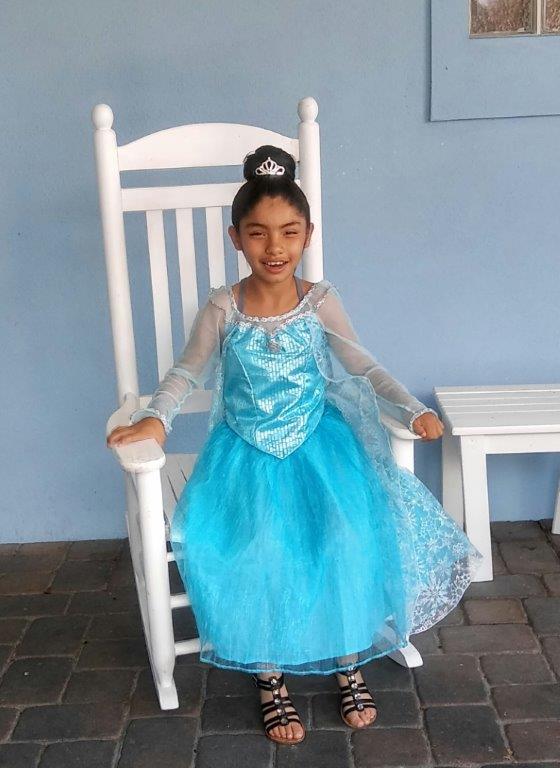Lizzie was born the day after New Year’s as a planned 2nd C-section. She was perfect! All I of what I had dreamed of. She had a head of beautiful dark hair. Her father and I were the happiest ever as she was our beautiful little girl. As I sat there holding my sleeping baby in my arms, I noticed that she had her tongue sticking out as she was sleeping. I thought it was cute but it gave me funny feeling about it since I have never seen a baby do that before. I asked the pediatrician about it but he said that I shouldn’t worry, that she was perfectly healthy. As the months pass by I’ve noticed that she wouldn’t hit the mile stones like the other babies. At her well child appointments I would ask her Pediatrician about it and he would tell me she’s just a laid-back baby. I believed him, her older brother was a very active baby so I thought she was lazy. At six months her Dad and I noticed that she would always stare off to the side like if she was thinking. We would always ask each other what she was thinking about. We never thought anything about it.
When she was a year old she barely was sitting up and had not tried to crawl, by then I was more worried. I asked her pediatrician what we should do, he recommended for her to see a geneticist. We had to wait 3 months for us to see him. The geneticist asked about her behavior among other things I told him about her staring to the side a lot. He ordered an EEG, hearing tests and vision tests. He couldn’t order a genetic test, because her insurance did not cover it at that time. She was diagnosed with cortical visual impairment, cognitive delays, and a seizure disorder. Her starring off to side is actually seizures. Who would have thought of that? They are called Absence seizures. She then was referred to see a Neurologist who has been treating her for her uncontrolled seizures. We went thru 6 different combinations of medications. At one point she was hospitalized due to excessive seizures, she was averaging 13 seizures an hour, that’s 312 seizures a day! At this point we were more worried about what her quality of life was going to be. We had given up hope in finding out what was causing her to be like this.
At almost 10 years old her neurologist suggested for her to see a different geneticist, just to see if there’s any test that is covered. Sure why not? The geneticist ordered a genetic test and the test came up with an answer, SYNGAP1.
In 2009, a rare chromosome disorder called SYNGAP1, where chromosome 6 is either mutated or deleted. It is an epilepsy disorder, and can present along with muscle weakness, cognitive impairment, severe speech and physical delays, and autistic type behaviors. It is a rare disease. As far as we know there’s about 250 people in the world with this condition.
We finally have an answer. We now know that we are not the only ones. There’s other children like her. Now we have hope. Now we know that she can have a good quality of life, just as long as we can control her seizures. Her neurologist has found a combination of medications that controls them at the moment.
We were able to connect with a support group called Bridge the Gap Syngap Foundation. There other families share their stories, their loved one accomplishments and daily struggles. Somewhere where we can vent to people that understand us. There are a team of specialists that are working hard in finding a cure for SYNGAP1. We are grateful for them, we have faith that someday they will find a cure.
EMAIL Maria.Villafana@HonorHealth.com
Bridge the Gap – SYNGAP Education and Research Foundation 501(c)3 is a non-profit organization whose mission is to serve, educate and fund research for families coping with the effects of SYNGAP1 mutations. We began in September of 2014 when a group of parents of children living with SYNGAP1 mutations came together to begin a new journey. Our programs aim to improve the quality of life, accelerating research, raising awareness and providing family support. The common bond is one drive by a desire to raise awareness and search out treatments to improve quality of life.
SYNGAP1 is a rare genetic disorder highly associated with developmental disability, autism, and epilepsy. It is caused by a mutation on the short arm of chromosome 6 (6p21.3).
The incidence of SYNGAP1 mutations reported are 1-4/10,000 individuals or approximately 1-2% of all cases of ID. The genetic mutation results in non-syndromic intellectual disability ranging from mild to severe and ninety-four percent (94%) of SYNGAP1 patients have been diagnosed with some form of epilepsy. It is also associated with attention deficits, impulsivity, and/or mood disorders. In recent findings SYNGAP1 has been a gene linked to autism. The percentage is unknown of how many of these individuals have been diagnosed autism. Early developmental intervention is important to insure that affected children reach their full potential. Most children benefit from occupational, physical and speech therapy. Currently there are no treatments as researchers and clinicians are still trying to understand the biology of the disease. Every family and every child with SYNGAP1 provides information that can guide us to a cure.

